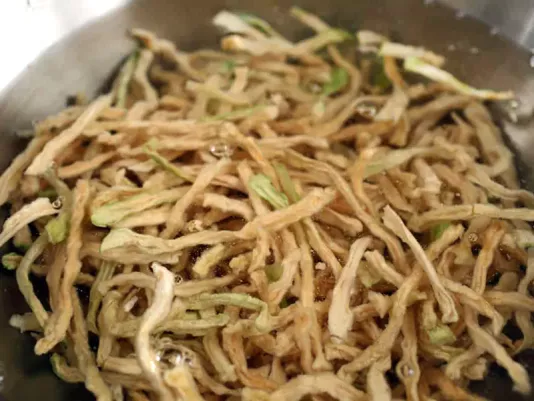Vegetarian Crab
Vegetarian crab - a Chinese cuisine recipe, potatoes, carrots and spices can imitate crab meat very well.

Dried Turnip is an ingredient that deserves more attention than it usually gets. Over the years of cooking, I’ve realized that drying makes turnip truly versatile. It becomes lighter, preserves vitamins, concentrates flavor, and allows for unhurried cooking. Before use, I always soak it in hot water for twenty minutes to restore its natural tenderness. Dried turnip pairs perfectly with grains, meat, mushrooms, or legumes – anywhere a subtle sweetness and firm texture are desired. It’s a true find for those who value traditional flavors in a modern rhythm.
When I buy or dry turnip myself, I always pay attention to color consistency and the absence of dark spots. Good dried turnip has a light golden or slightly amber hue, and its slices are flexible but not moist. If the product is too brittle or has a musty odor, it indicates improper drying or storage conditions. Over the years, I’ve found that the best way to dry turnip is in thin slices – no thicker than five millimeters. This way it dries quickly and retains its color. Store it in a tightly sealed jar in a dry place away from sunlight. Sometimes I add a few grains of rice or a dry bay leaf to prevent moisture and insects. If you’re unsure about store-bought quality, it’s better to choose a trusted producer or make it yourself using an oven at about 55-60°C (130-140°F) with the door slightly open for air circulation. This method provides a clean, natural aroma and ensures that the turnip retains its beneficial properties.
Before cooking, I always soak turnip in warm water so it softens and regains some of its natural juices. The optimal time is between twenty minutes and an hour, depending on the thickness of the slices. If I plan to use it in soup, I never pour out the soaking water – it contains a concentrated aroma that deepens the flavor. When turnip goes into porridge or pie, I lightly sauté it in butter until light golden, giving it a delicate caramel note. From experience, over-soaking makes the texture sticky and shapeless, so timing is key. To preserve its aroma, I use only glass or ceramic dishes, as metal can affect the scent. Before adding it to a dish, I always blot the turnip with a towel to remove excess moisture, then combine it with other ingredients. This preparation ensures balanced flavor and a pleasant, non-watery texture.
Dried turnip requires a delicate approach to temperature. Over high heat, it quickly loses its shape and turns bitter. That’s why I always use medium or low heat, gradually incorporating it into the dish. If I cook it as a side, I first sauté it with a bit of oil, add onion or carrot, and then pour in some broth or cream. The key is not to overheat – it should warm through evenly without browning on the outside. In my experience, the oven temperature should not exceed 160°C (320°F) when baking it as part of a vegetable mix. This setting helps preserve its color and tenderness. When slowly stewed in a pot or sauté pan, the flavor develops fully, resulting in a soft texture without dryness. If turnip is added to soup or stew, it’s important to put it in after the liquid has boiled but before adding spices, so its aroma unfolds naturally. Temperature control ensures that dried turnip retains both color and aroma.
Dried turnip has a sweet, earthy profile, making it easy to combine with sour or spicy components. I often use it with beans, lentils, or potatoes – these combinations create hearty yet light dishes. It also works well with poultry, especially turkey or chicken: its aroma gently enhances the protein base. For a touch of delicacy, I add a bit of cream or white wine – they soften the natural richness of the vegetable. In dishes with grains, particularly millet or buckwheat, turnip provides a pleasant balance of sweetness and thickness. From experience, I recommend using spices sparingly: a pinch of dried dill or coriander is better than strong blends. Dried turnip also pairs beautifully with mushrooms – their combined aroma evokes a sense of home comfort. With the right balance of textures, it doesn’t get lost among other ingredients but instead adds depth and harmony to the dish.
The most common mistake is using poorly dried turnip. Excess moisture can cause mold or unpleasant odor during cooking. I always inspect the product before soaking: if the pieces are sticky or have dark spots, it’s better not to risk it. Another frequent issue is over-frying. On high heat, turnip loses its aroma and becomes bitter. To avoid this, I cook it over low heat, stirring constantly. It’s also important to maintain cleanliness during drying and storage – even a small amount of moisture can ruin your supply. That’s why I always dry the jars before storing and check their contents every few weeks. Avoid mixing turnip with aromatic herbs during drying – they absorb its scent. If you need to sterilize turnip for long-term storage, simply heat it in the oven at 90°C (195°F) for about twenty minutes. This method is safe and effective. Following these guidelines ensures the ingredient remains high-quality and safe for any dish.